Discover 11 hidden attractions, cool sights, and unusual things to do in Lizard (United Kingdom). Don't miss out on these must-see attractions: Trebah, Lizard Lighthouse, and St Grada and Holy Cross Church. Also, be sure to include Kynance Cove in your itinerary.
Below, you can find the list of the most amazing places you should visit in Lizard (England).
Table of Contents
Trebah

Botanical garden in England. Trebah is a 26-acre sub-tropical garden situated in Cornwall, England, UK, near Glendurgan Garden and above the Helford River. Part of the parish of Mawnan, the gardens are set within an area of the same name, which includes the small settlements of Trebah Wartha and Trebah Woolas.[1]
Address: Trebah Garden Trust, Mawnan Smith, Near Falmouth, Cornwall, Lizard
Lizard Lighthouse
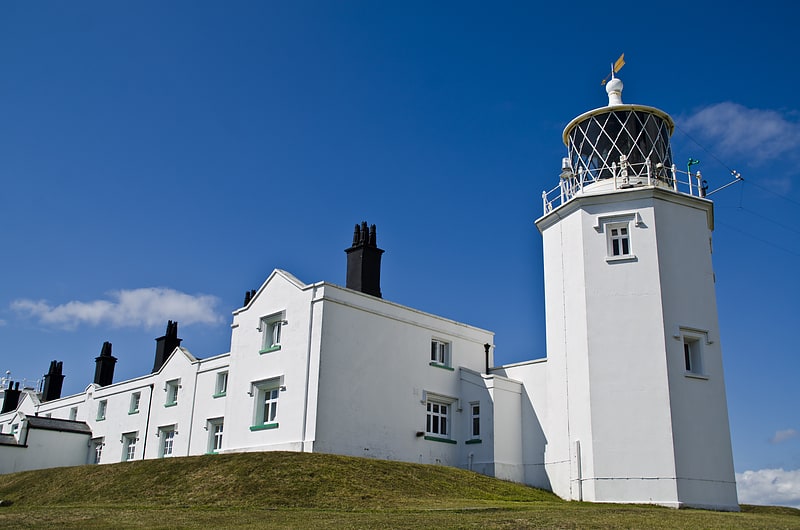
18th-century landmark with a museum. The Lizard Lighthouse is a lighthouse at Lizard Point, Cornwall, England, built to guide vessels passing through the English Channel. It was often the welcoming beacon to persons returning to England, where on a clear night, the reflected light could be seen 100 mi away.[2]
Address: 3 Lighthouse Rd, TR12 7NT Helston
St Grada and Holy Cross Church
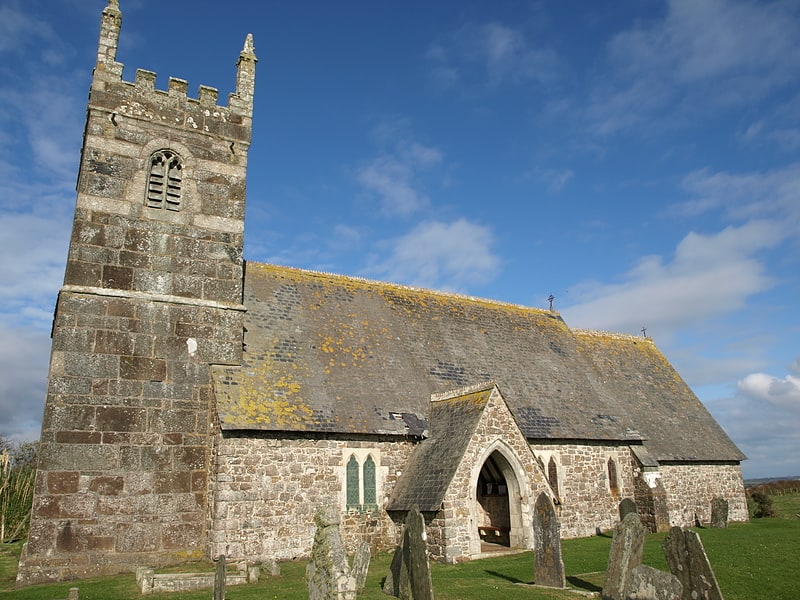
Anglican church in England. St Grada & Holy Cross Church, Grade is the Church of England parish church of Grade with Ruan, Cornwall. The church is a Grade I listed building, having been added to the listed buildings register on 10 July 1957.
This unique church is on the Heritage At Risk Register under List Entry Number: 1141938 2018 it is described as:
“a small church in an isolated site... the slate roof needs repair and the tower has excessive damp..… the Condition is Poor and the Priority A - immediate risk of further rapid deterioration or loss of fabric; no solution agreed.”
Restoration Appeal The church’s elevated and exposed position on the Lizard Peninsula makes it particularly vulnerable to winter gales which dislodge roof slates. Although these are replaced as soon as possible by a skilled local slater, this represents a continuing drain on scarce parish finances and the slater has drawn attention to the poor state of the underlying roof structure. There has been a longstanding re-roofing appeal which for many years has been dormant. However the 2019 quinquennial inspection, carried out by Scott & Co of Truro, recommended a complete renovation of the church. Estimates were sought from local contractors, the one selected totals just over £300,000 +VAT. The Friends of St Ruan and St Grade Historic Church Buildings have broken the project into phases. Phase 1 is for the urgent replacement of the roof of the nave and chancel at a cost of approximately £100,000.
You can donate on our Just Giving Page https:www.justgiving.com/campaign/StGradeAppeal Or contact us through our website by searching The Friends of St Ruan and St Grade Historic Church Buildings.
To view a Virtual 3D Tour of the Church, please go to our website (https:www.friendsofstruanandstgrade.co.uk/the-churches/#virtual_tour).[3]
Kynance Cove
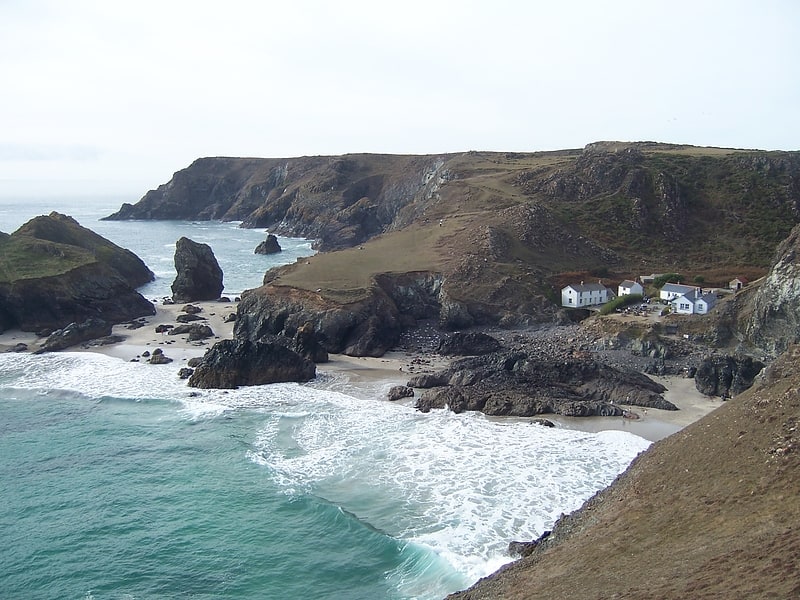
Cove in the United Kingdom. Kynance Cove is a cove on the eastern side of Mount's Bay, Cornwall, England. It is situated on the Lizard peninsula approximately two miles north of Lizard Point. The cove became popular in the early Victorian era, with many distinguished visitors including Queen Victoria and Prince Albert and the poet Alfred Tennyson. The BBC has described Kynance Cove as "one of the most beautiful stretches of coastline in the South West". The South West Coast Path, which follows the coast of south west England from Somerset to Dorset passes by on the cliffs overlooking the cove.
Kynance Cove and the surrounding coast are owned and managed by the National Trust. It is part of the West Lizard Site of Special Scientific Interest and is in the Cornwall Area of Outstanding Natural Beauty. The Kynance Café, which opened for business in 1929, relied on spring water and on a generator for power. When the café became the property of the National Trust in 1999, the Trust renovated it and provided mains water and electricity. Access is via the South-west coastal footpath from the nearby National Trust car park.[4]
Cadgwith
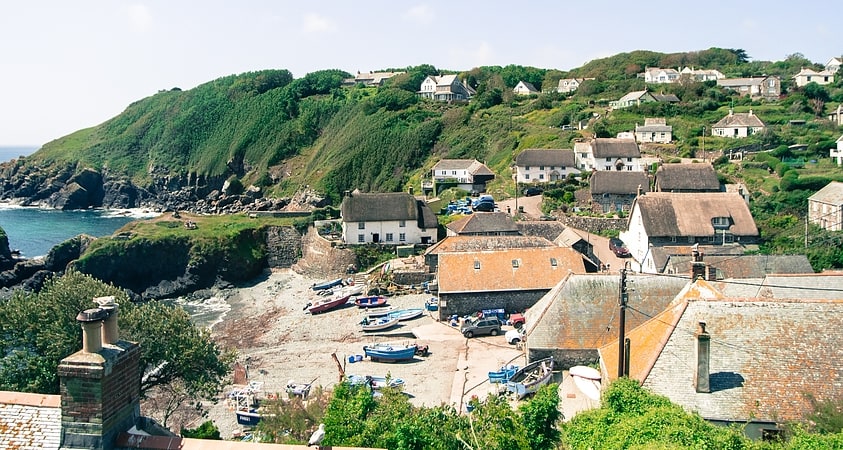
Village in England. Cadgwith is a village and fishing port in Cornwall, England, United Kingdom. It is on the Lizard Peninsula between The Lizard and Coverack. It is in the civil parish of Grade Ruan.[5]
Poltesco
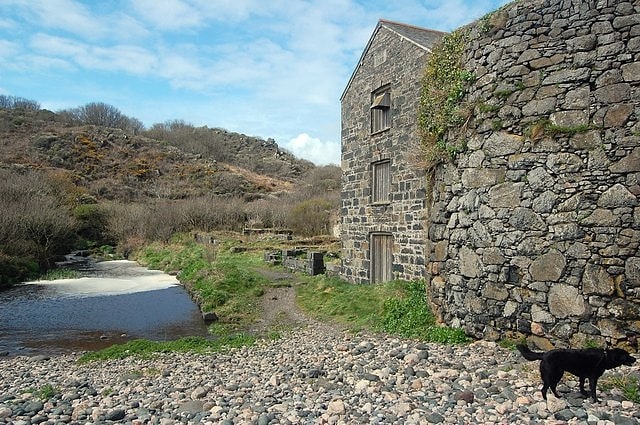
Hamlet in England. Poltesco is a hamlet and valley in the parish of Grade-Ruan, on the Lizard Peninsula, Cornwall, UK. The lower part of the valley is owned by the National Trust and was once the site of a stone industry that exported carved ornaments to the rest of Britain and Europe.[6]
St Wynwallow's Church
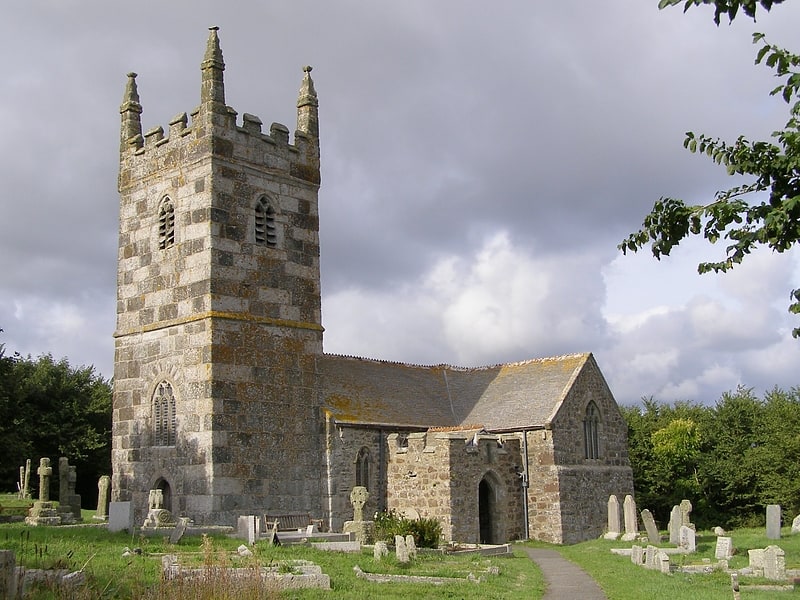
Anglican church in Landewednack, England. St Wynwallow's Church, Landewednack, is the parish church of Landewednack parish in Cornwall, England, United Kingdom. It is the most southerly church in mainland Britain and is situated approximately ten miles south of Helston. It was founded about 600 AD but the present structure dates to the twelfth century.[7]
Lizard Point
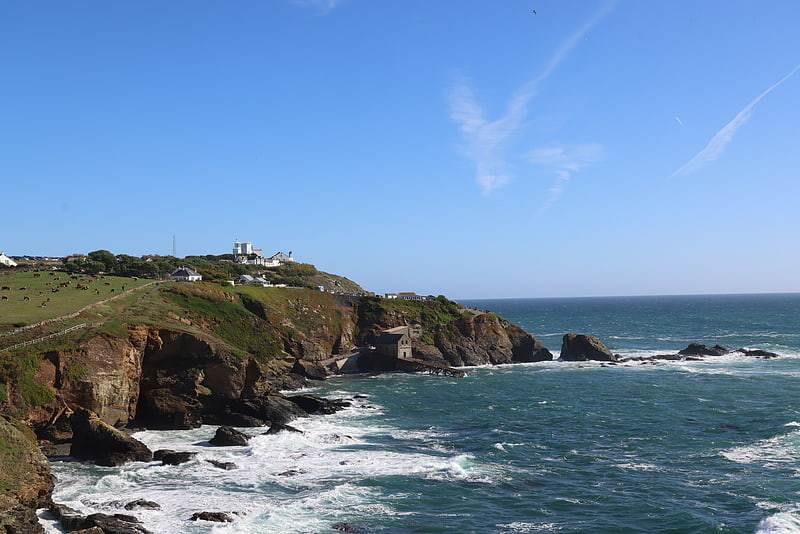
Rocky coastline with scenic views. Lizard Point in Cornwall is at the southern tip of the Lizard Peninsula. It is situated half-a-mile south of Lizard village in the civil parish of Landewednack and about 11 miles southeast of Helston.
Lizard Point is the most southerly point on mainland Great Britain at 49° 57' 30" N. With the exception of parts of the Isles of Scilly, it is the southernmost part of England and the wider United Kingdom.[8]
Kennack to Coverack
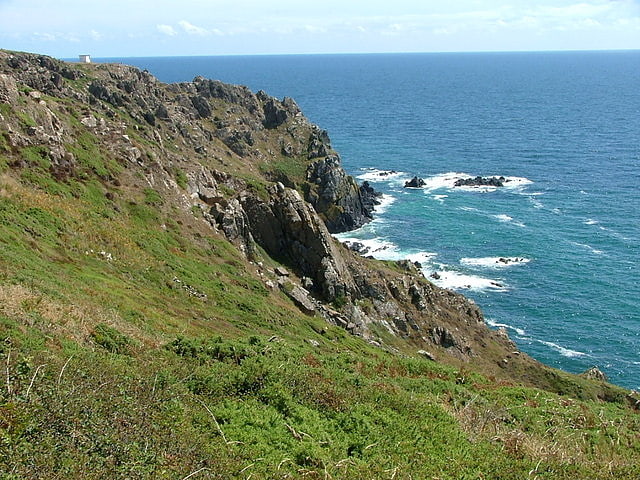
Kennack to Coverack is a coastal Site of Special Scientific Interest on the Lizard Peninsula in Cornwall, England, UK, noted for both its biological and geological interest. It is of botanical importance, with 8 Red Data Book of rare and endangered plant species being found on the site as well as other nationally scarce varieties.[9]
Grade–Ruan
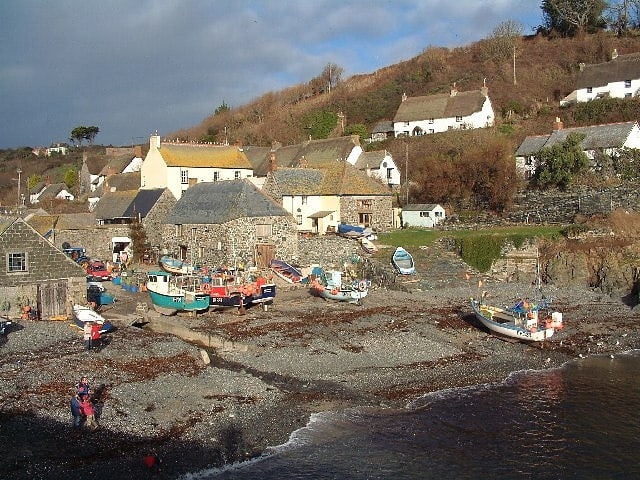
English civil parish. Grade–Ruan is a civil parish on the Lizard peninsula in Cornwall, England, United Kingdom, approximately ten miles south of Falmouth.
It is a rural parish bounded to the east by St Keverne parish and by the sea; to the west by Mullion and Cury parishes; and to the south by Landewednack parish.
Grade–Ruan civil parish encompasses part of Goonhilly Downs and the major settlements are Ruan Minor, St Ruan and Cadgwith. The parish was formed in 1934 because falling population necessitated merging the ecclesiastical parishes of Grade, Ruan Major and Ruan Minor. All three were in the Deanery and Hundred of Kerrier. Formerly, Cadgwith was partly in Grade parish and partly in Ruan Minor parish.
The population of Grade–Ruan has increased steadily; it was 677 in 1961, 835 in 1981, 1070 in 2001, and 936 in 2011. There is a school in the parish, Grade Ruan CE Primary School, which is situated in Ruan Minor.
Grade–Ruan lies within the Cornwall Area of Outstanding Natural Beauty.
The parish churches of the three former parishes are St Grada at Grade, and the churches of Ruan Major and Ruan Minor, the latter two dedicated to St Rumonus. All three have towers though Ruan Minor Church tower is very small. Ruan Major Church was greatly altered by Edmund Sedding in 1867 and is now a ruin. The church of Ruan Major lay within the manor of Winnianton; its benefice was united with that of Landewednack in 1754. The church of St Rumon in Ruan Major is a grade I listed building.
The church of Ruan Minor also lay within the manor of Winnianton; it was a separate rectory in 1277. The church is a small mainly 15th century building and has a Norman piscina.
Erisey Manor House is a Grade II listed farmhouse. The oldest part is part of a house built in an E shape in 1620; this has been incorporated in an 18th-century rebuilding and extensions. The 1620 house was built by Richard Erisey; the Erisey male line came to an end in 1772. James Erisey was born at an earlier Erisey House; he sailed as a privateer with Sir Francis Drake.[10]
Caerthillian to Kennack
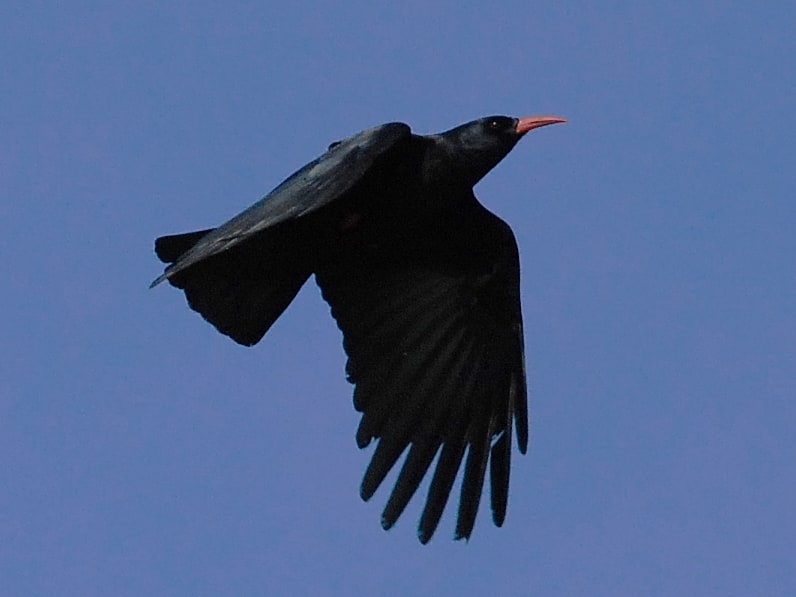
Caerthillian to Kennack is a coastal Site of Special Scientific Interest on the Lizard Peninsula in Cornwall, UK, noted for both its biological and geological characteristics. It is of great botanical importance, with several Red Data Book of rare and endangered plant species being found on the site, as well as a breeding site for Cornish choughs.[11]